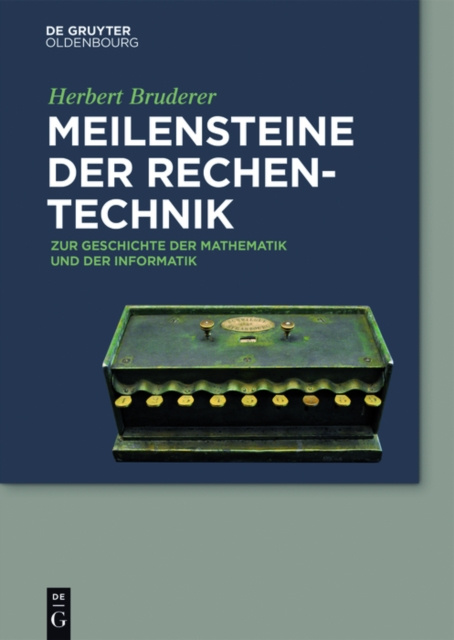
Doručenie
Nákupný poradca





Nehodí sa? Žiadny problém! U nás môžete do 30 dní vrátiť
 Darčekový poukaz
v ľubovoľnej hodnote
Darčekový poukaz
v ľubovoľnej hodnote
S darčekovým poukazom nešliapnete vedľa. Obdarovaný si za darčekový poukaz môže vybrať čokoľvek z našej ponuky.
Meilensteine der Rechentechnik
 Nemčina
Nemčina
 367 b
367 b


* Numerous recent discoveries of rare historical analog and digital calculators and previously unknown texts, drawings, and pictures from Germany, Austria, Switzerland, Liechtenstein, and France. * Worldwide, multilingual bibliography regarding the history of computer science with over 3000 entries. * 12 step-by-step set of instructions for the operation of historical analog and digital calculating devices. * 75 comparative overviews in tabular form. * 200 illustrations. * 20 comprehensive lists. * 7 timelines of computer history. During the 1970s mechanical calculating instruments and machines suddenly disappeared from the scene. They were replaced by electronic versions. Most of these devices developed since the 17th century - often very clever constructions - have been forgotten. Who can imagine today how difficult calculation was only a few decades ago? This book introduces the reader to selected milestones from prehistory and early history of computing. The Antikythera Mechanism This puzzling device was made around 200 BC. It was discovered around 1900 by divers off the Greek island of Antikythera. It is believed to be the oldest known analog (or rather hybrid) computing device. Numerous replicas have been built to unravel the mysteries of this calendar calculator. It is suspected that the machine came from the school of Archimedes. Androids, Music Boxes, Chess Automatons, Looms This treatise also explores topics related to computing technology: automated human and animal figures, mecha-nized musical instruments, music boxes, as well as punched tape controlled looms and typewriters. Also men-tioned are the chess playing machines of the highly gifted Spanish scholar Torres Quevedo (20th century), the magnificent androids (artificial humans) of the Neuchatel clockmaker Jaquet-Droz (18th century), and his splen-did still functional programmable handwriting automaton "e;The Writer"e;. A similar machine can also be seen in Vienna. Schickard, Pascal, and Leibniz During the 17th century broadly gifted geniuses from Germany and France tried to build calculating machines. Developing a mechanism to perform decimal carry was very challenging. Famous calculators are covered in the text and pictures. These ornate works of art, often circular in form, were popular presents for royalty. Only in the 19th century did makers succeed in producing useful four function calculators. The first successful, commercial-ly produced device was the Thomas Arithmometer, made in Paris. This book lists, for the first time, all the known Swiss makers of mechanical calculating machines and compares their products with one another. The most famous firms were Egli AG (maker of the "e;Millionaire"e; and the "e;Madas"e;) and Pecisa AG. Both companies were located in Zurich. In the 1950s Heinz Rutishauser, the inventor of automatic programming, used a Madas at the ETH (Swiss Federal Institute of Technology) Zurich. Sectors, Proportional Compasses, Polar Planimeters, Pantographs, and Coordinatographs Here the discussion is about exceptionally versatile analog calculation instruments such as sectors and propor-tional compasses (dividers). Vanished and forgotten are the products of the world's former leading makers of mechanical integrators such as Amsler (Schaffhausen), Coradi (Zurich), and Ott (Kempten). They also made planimeters and pantographs. These were used in land surveying offices and the textile industry (knitting). Counting Boards During the middle ages and in more recent times many city halls had a beautiful carved counting board. These tables were used for performing calculations using coins. This method was later replaced by written calculation. Only a few counting boards have survived, mostly in Switzerland, Germany, and France. The Oldest Preserved Key-driven Adding Machine in World The most important international discovery concerns Jean-Baptiste Schwilgue, the creator of the astronomical clock in the Cathedral in Strasbourg. The oldest preserved keyboard adding machine in the world (19th century) came to light next to an early Thomas Arithmometer in the collection of the observatory at ETH Zurich. This machine is featured on the cover of this book. Two examples of this machine have survived, an older one in Strasbourg and a later one in Zurich. The latter is in far better condition. Process Computer for the Astronomical Clock at the Cathedral of Strasbourg An additional big surprise was the discovery (in December 2014) of a rare large adding machine in the Strasbourg Historical Museum. Research has indicated that this adding machine was used to calculate the settings for a very precise milling machine used to make the gears of the astronomical clock at the Cathedral of Strasbourg. The results of calculations were transcribed by hand to a paper tape. This was put in a small box with rollers which was attached to the milling machine. Thus this formed a simple "e;process ...
Informácie o knihe
 Nemčina
Nemčina




 Ako nakupovať
Ako nakupovať

















